Rational Design, Synthesis, Separation, and Characterization of New Spiroxindoles Combined with Benzimidazole Scaffold as an MDM2 Inhibitor
Abstract
1. Introduction
2. Materials and Methods
2.1. General
2.2. Synthesis of Spirooxindole Analogues (7a-o) General Procedure)
- 2’-(1H-Benzo[d]imidazole-2-carbonyl)-5-chloro-1’-(4-chlorophenyl)-1’,2’,4a’,5’,6’,7’,8’,8a’,9’,9a’-decahydrospiro[indoline-3,3’-pyrrolo [1,2-a]indol]-2-one (7a).
- 2’-(1H-Benzo[d]imidazole-2-carbonyl)-5-chloro-1’-(4-(trifluoromethyl)phenyl)-1’,2’,4a’,5’,6’,7’,8’,8a’,9’,9a’-decahydrospiro[indoline-3,3’-pyrrolo[1,2-a]indol]-2-one (7b).
- 2’-(1H-Benzo[d]imidazole-2-carbonyl)-5-chloro-1’-(p-tolyl)-1’,2’,4a’,5’,6’,7’,8’,8a’,9’,9a’-decahydrospiro[indoline-3,3’-pyrrolo[1,2-a]indol]-2-one (7c).
- 2’-(1H-Benzo[d]imidazole-2-carbonyl)-5-chloro-1’-(thiophen-2-yl)-1’,2’,4a’,5’,6’,7’,8’,8a’,9’,9a’-decahydrospiro[indoline-3,3’-pyrrolo[1,2-a]indol]-2-one (7d).
- 2’-(1H-Benzo[d]imidazole-2-carbonyl)-5-chloro-1’-(4-fluorophenyl)-1’,2’,4a’,5’,6’,7’,8’,8a’,9’,9a’-decahydrospiro[indoline-3,3’-pyrrolo[1,2-a]indol]-2-one (7e).
- 2’-(1H-Benzo[d]imidazole-2-carbonyl)-5-chloro-1’-(2,4-dichlorophenyl)-1’,2’,4a’,5’,6’,7’,8’,8a’,9’,9a’-decahydrospiro[indoline-3,3’-pyrrolo[1,2-a]indol]-2-one (7f).
- 2’-(1H-Benzo[d]imidazole-2-carbonyl)-5-chloro-1’-(3-hydroxyphenyl)-1’,2’,4a’,5’,6’,7’,8’,8a’,9’,9a’-decahydrospiro[indoline-3,3’-pyrrolo[1,2-a]indol]-2-one (7g).
- 2’-(1H-Benzo[d]imidazole-2-carbonyl)-5-chloro-1’-(3,4,5-trimethoxyphenyl)-1’,2’,4a’,5’,6’,7’,8’,8a’,9’,9a’-decahydrospiro[indoline-3,3’-pyrrolo[1,2-a]indol]-2-one (7h).
- 2’-(1H-Benzo[d]imidazole-2-carbonyl)-5-chloro-1’-(2-hydroxyphenyl)-1’,2’,4a’,5’,6’,7’,8’,8a’,9’,9a’-decahydrospiro[indoline-3,3’-pyrrolo[1,2-a]indol]-2-one (7i).
- 2’-(1H-Benzo[d]imidazole-2-carbonyl)-5-chloro-1’-(4-(dimethylamino)phenyl)-1’,2’,4a’,5’,6’,7’,8’,8a’,9’,9a’-decahydrospiro[indoline-3,3’-pyrrolo[1,2-a]indol]-2-one (7j).
- 2’-(1H-Benzo[d]imidazole-2-carbonyl)-1’-(4-bromophenyl)-5-chloro-1’,2’,4a’,5’,6’,7’,8’,8a’,9’,9a’-decahydrospiro[indoline-3,3’-pyrrolo[1,2-a]indol]-2-one (7k).
- 2’-(1H-Benzo[d]imidazole-2-carbonyl)-5-chloro-1’-(3-fluorophenyl)-1’,2’,4a’,5’,6’,7’,8’,8a’,9’,9a’-decahydrospiro[indoline-3,3’-pyrrolo[1,2- a]indol]-2-one (7l).
- 2’-(1H-Benzo[d]imidazole-2-carbonyl)-5-chloro-1’-(furan-2-yl)-1’,2’,4a’,5’,6’,7’,8’,8a’,9’,9a’-decahydrospiro[indoline-3,3’-pyrrolo[1,2- a]indol]-2-one (7m).
- 2’-(1H-Benzo[d]imidazole-2-carbonyl)-5-chloro-1’-(4-nitrophenyl)-1’,2’,4a’,5’,6’,7’,8’,8a’,9’,9a’-decahydrospiro[indoline-3,3’-pyrrolo[1,2- a]indol]-2-one (7n).
- 2’-(1H-benzo[d]imidazole-2-carbonyl)-5-chloro-1’-(3-nitrophenyl)-1’,2’,4a’,5’,6’,7’,8’,8a’,9’,9a’-decahydrospiro[indoline-3,3’-pyrrolo[1,2- a]indol]-2-one (7o).
2.3. NCI Screening
2.4. Anticancer Activity Protocol
2.5. MDM2 Binding Analysis by Microscale Thermophoresis (MST) Assay
2.6. Methodology for Molecular Docking
2.7. Statistical Analysis
3. Results and Discussion
3.1. Chemistry
3.2. In Vitro Anti-Cancer Activity Assays
3.2.1. NCI Screening (Development Therapeutic Program, DTP)
3.2.2. MTT Assay
3.2.3. Microscale Thermophoresis Assay (MST) for MDM2 Binding Detection
3.3. Molecular Docking of the Studied Compound
4. Conclusions
Supplementary Materials
Author Contributions
Funding
Institutional Review Board Statement
Informed Consent Statement
Data Availability Statement
Acknowledgments
Conflicts of Interest
References
- Xue, P.; Zhang, Z.; Sun, S. Targeting p53-MDM2 Interaction by Small Molecule Inhibitors: A Promising Strategy for Cancer Treatment. Int. J. Mol. Sci. 2019, 20, 64. [Google Scholar]
- Masuda, H.; Takahashi, M.; Takahashi, R. Small-molecule inhibitors targeting the p53-MDM2 interaction for cancer therapy. Drug Discov. Today 2018, 23, 774–784. [Google Scholar]
- Zhou, X.; Xu, X.; Huang, P. Small-molecule inhibitors targeting the p53-MDM2 interaction for cancer therapy: A review. Bioorg. Med. Chem. 2016, 24, 4710–4717. [Google Scholar]
- Zhu, H.; Gao, H.; Ji, Y.; Zhou, Q.; Du, Z.; Tian, L.; Jiang, Y.; Yao, K.; Zhou, Z. Targeting p53–MDM2 interaction by small-molecule inhibitors: Learning from MDM2 inhibitors in clinical trials. J. Hematol. Oncol. 2022, 15, 91. [Google Scholar] [CrossRef]
- Zhuang, C.; Miao, Z.; Zhu, L.; Dong, G.; Guo, Z.; Wang, S.; Zhang, Y.; Wu, Y.; Yao, J.; Sheng, C.; et al. Discovery, synthesis, and biological evaluation of orally active pyrrolidone derivatives as novel inhibitors of p53-MDM2 protein-protein interaction. J. Med. Chem. 2012, 55, 9630–9642. [Google Scholar] [CrossRef]
- Ding, K.; Lu, Y.; Nikolovska-Coleska, Z.; Wang, G.; Qiu, S.; Shangary, S.; Gao, W.; Qin, D.; Stuckey, J.; Krajewski, K.; et al. Structure-based design of spiro-oxindoles as potent, specific small-molecule inhibitors of the MDM2-p53 interaction. J. Med. Chem. 2006, 49, 3432–3435. [Google Scholar] [CrossRef]
- Sanz, G.; Singh, M.; Peuget, S.; Selivanova, G. Inhibition of p53 inhibitors: Progress, challenges and perspectives. J. Mol. Cell Biol. 2019, 11, 586–599. [Google Scholar] [CrossRef]
- Zhang, Q.; Zeng, S.X.; Lu, H. Targeting p53-MDM2-MDMX loop for cancer therapy. In Mutant p53 and MDM2 in Cancer; Springer: Berlin/Heidelberg, Germany, 2014; pp. 281–319. [Google Scholar]
- Ding, K.; Lu, Y.; Nikolovska-Coleska, Z.; Qiu, S.; Ding, Y.; Gao, W.; Stuckey, J.; Krajewski, K.; Roller, P.P.; Tomita, Y.; et al. Structure-based design of potent non-peptide MDM2 inhibitors. J. Am. Chem. Soc. 2005, 127, 10130–10131. [Google Scholar] [CrossRef]
- Fry, D.C.; Emerson, S.D.; Palme, S.; Vu, B.T.; Liu, C.M.; Podlaski, F. NMR structure of a complex between MDM2 and a small molecule inhibitor. J. Biomol. NMR 2004, 30, 163–173. [Google Scholar] [CrossRef]
- Rothweiler, U.; Czarna, A.; Krajewski, M.; Ciombor, J.; Kalinski, C.; Khazak, V.; Ross, G.; Skobeleva, N.; Weber, L.; Holak, T.A. Isoquinolin-1-one inhibitors of the MDM2-p53 interaction. Chem. Med. Chem. 2008, 3, 1118–1128. [Google Scholar] [CrossRef]
- Kumar, S.K.; Hager, E.; Pettit, C.; Gurulingappa, H.; Davidson, N.E.; Khan, S.R. Design, Synthesis, and Evaluation of Novel Boronic-Chalcone Derivatives as Antitumor Agents. J. Med. Chem. 2003, 46, 2813–2815. [Google Scholar] [CrossRef]
- Surmiak, E.; Twarda-Clapa, A.; Zak, K.M.; Musielak, B.; Tomala, M.D.; Kubica, K.; Grudnik, P.; Madej, M.; Jablonski, M.; Potempa, J.; et al. A Unique Mdm2-Binding Mode of the 3-Pyrrolin-2-one- and 2-Furanone-Based Antagonists of the p53-Mdm2 Interaction. ACS Chem. Biol. 2016, 11, 3310–3318. [Google Scholar] [CrossRef]
- Yang, M.C.; Peng, C.; Huang, H.; Yang, L.; He, X.H.; Huang, W.; Cui, H.L.; He, G.; Han, B. Organocatalytic Asymmetric Synthesis of Spiro-oxindole Piperidine Derivatives That Reduce Cancer Cell Proliferation by Inhibiting MDM2-p53 Interaction. Org. Lett. 2017, 19, 6752–6755. [Google Scholar] [CrossRef]
- Gonzalez, A.Z.; Eksterowicz, J.; Bartberger, M.D.; Beck, H.P.; Canon, J.; Chen, A.; Chow, D.; Duquette, J.; Fox, B.M.; Fu, J.; et al. Selective and potent morpholinone inhibitors of the MDM2-p53 protein-protein interaction. J. Med. Chem. 2014, 57, 2472–2488. [Google Scholar] [CrossRef]
- Furet, P.; Chene, P.; De Pover, A.; Valat, T.S.; Lisztwan, J.H.; Kallen, J.; Masuya, K. The central valine concept provides an entry in a new class of non peptide inhibitors of the p53-MDM2 interaction. Bioorg. Med. Chem. Lett. 2012, 22, 3498–3502. [Google Scholar] [CrossRef]
- Koblish, H.K.; Zhao, S.; Franks, C.F.; Donatelli, R.R.; Tominovich, R.M.; LaFrance, L.V.; Leonard, K.A.; Gushue, J.M.; Parks, D.J.; Calvo, R.R.; et al. Benzodiazepinedione inhibitors of the Hdm2:p53 complex suppress human tumor cell proliferation in vitro and sensitize tumors to doxorubicin in vivo. Mol. Cancer Ther. 2006, 5, 160–169. [Google Scholar] [CrossRef]
- Pettersson, M.; Quant, M.; Min, J.; Iconaru, L.; Kriwacki, R.W.; Waddell, M.B.; Guy, R.K.; Luthman, K.; Grotli, M. Design, Synthesis and Evaluation of 2,5-Diketopiperazines as Inhibitors of the MDM2-p53 Interaction. PLoS ONE 2015, 10, e0137867. [Google Scholar] [CrossRef]
- Allen, J.G.; Bourbeau, M.P.; Wohlhieter, G.E.; Bartberger, M.D.; Michelsen, K.; Hungate, R.; Gadwood, R.C.; Gaston, R.D.; Evans, B.; Mann, L.W.; et al. Discovery and optimization of chromenotriazolopyrimidines as potent inhibitors of the mouse double minute 2-tumor protein 53 protein-protein interaction. J. Med. Chem. 2009, 52, 7044–7053. [Google Scholar] [CrossRef]
- Aguilar, A.; Lu, J.; Liu, L.; Du, D.; Bernard, D.; McEachern, D.; Przybranowski, S.; Li, X.; Luo, R.; Wen, B.; et al. Discovery of 4-((30R,40S,50R)-6′-Chloro-40-(3-chloro-2-fluorophenyl)-10-ethyl-2′-oxodispiro[cyclohexane-1,20pyrrolidine-30,3′-indoline]-50—carboxamido)bicyclo[2.2.2]octane-1-carboxylic Acid (AA-115/APG-115): A Potent and Orally Active Murine Double Minute 2 (MDM2) Inhibitor in Clinical Development. J. Med. Chem. 2017, 60, 2819–2839. [Google Scholar]
- De Jonge, M.; de Weger, V.A.; Dickson, M.A.; Langenberg, M.; Le Cesne, A.; Wagner, A.J.; Hsu, K.; Zheng, W.; Mace, S.; Tuffal, G.; et al. A phase I study of SAR405838, a novel human double minute 2 (HDM2) antagonist, in patients with solid tumours. Eur. J. Cancer 2017, 76, 144–151. [Google Scholar] [CrossRef]
- Zanjirband, M.; Edmondson, R.J.; Lunec, J. Pre-clinical efficacy and synergistic potential of the MDM2-p53 antagonists, Nutlin-3 and RG7388, as single agents and in combined treatment with cisplatin in ovarian cancer. Oncotarget 2016, 7, 40115–40134. [Google Scholar] [CrossRef] [PubMed]
- Novartis Pharmaceuticals. Study of Safety and Efficacy of HDM201 in Combination with LEE011 in Patients with Liposarcoma. ClinicalTrials. Gov Identifier: NCT02343172. 2015. Available online: https://clinicaltrials.gov/ct2/show/NCT02343172 (accessed on 13 February 2023).
- Andreeff, M.; Kelly, K.R.; Yee, K.; Assouline, S.; Strair, R.; Popplewell, L.; Bowen, D.; Martinelli, G.; Drummond, M.W.; Vyas, P.; et al. Results of the Phase I Trial of RG7112, a Small-Molecule MDM2 Antagonist in Leukemia. Clin. Cancer Res. 2016, 22, 868–876. [Google Scholar] [CrossRef] [PubMed]
- Sun, D.; Li, Z.; Rew, Y.; Gribble, M.; Bartberger, M.D.; Beck, H.P.; Canon, J.; Chen, A.; Chen, X.; Chow, D.; et al. Discovery of AMG 232, a potent, selective, and orally bioavailable MDM2-p53 inhibitor in clinical development. J. Med. Chem. 2014, 57, 1454–1472. [Google Scholar] [CrossRef] [PubMed]
- Zhao, Y.; Liu, L.; Sun, W.; Lu, J.; McEachern, D.; Li, X.; Yu, S.; Bernard, D.; Ochsenbein, P.; Ferey, V.; et al. Diastereomeric spirooxindoles as highly potent and efficacious MDM2 inhibitors. J. Am. Chem. Soc. 2013, 135, 7223–7234. [Google Scholar] [CrossRef]
- Tovar, C.; Graves, B.; Packman, K.; Filipovic, Z.; Xia, B.H.M.; Tardell, C.; Garrido, R.; Lee, E.; Kolinsky, K.; To, K.H.; et al. MDM2 small-molecule antagonist RG7112 activates p53 signaling and regresses human tumors in preclinical cancer models. Cancer Res. 2013, 73, 2587–2597. [Google Scholar] [CrossRef]
- Beloglazkina, A.; Zyk, N.; Majouga, A.; Beloglazkina, E. Recent small-molecule inhibitors of the p53–MDM2 protein–protein interaction. Molecules 2020, 25, 1211. [Google Scholar] [CrossRef]
- Riedinger, C.; McDonnell, J.M. Inhibitors of MDM2 and MDMX: A structural perspective. Future Med. Chem. 2009, 1, 1075–1094. [Google Scholar] [CrossRef]
- Millard, M.; Pathania, D.; Grande, F.; Xu, S.; Neamati, N. Small-molecule inhibitors of p53-MDM2 interaction: The 2006–2010 update. Curr. Pharm. Des. 2011, 17, 536–559. [Google Scholar] [CrossRef]
- Vassilev, L.T. MDM2 inhibitors for cancer therapy. Trends Mol. Med. 2007, 13, 23–31. [Google Scholar] [CrossRef]
- Zhang, Z.; Chu, X.J.; Liu, J.J.; Ding, Q.; Zhang, J.; Bartkovitz, D.; Jiang, N.; Karnachi, P.; So, S.S.; Tovar, C.; et al. Discovery of potent and orally active p53-MDM2 inhibitors RO5353 and RO2468 for potential clinical development. ACS Med. Chem. Lett. 2014, 5, 124–127. [Google Scholar] [CrossRef]
- Cui, C.B.; Kakeya, H.; Osada, H. Spirotryprostatin B, a novel mammalian cell cycle inhibitor produced by Aspergillus fumigatus. J. Antibiot. 1996, 49, 832–835. [Google Scholar] [CrossRef]
- Gollner, A.; Rudolph, D.; Arnhof, H.; Bauer, M.; Blake, S.M.; Boehmelt, G.; Cockroft, X.L.; Dahmann, G.; Ettmayer, P.; Gerstberger, T.; et al. Discovery of novel spiro [3 H-indole-3, 2′-pyrrolidin]-2 (1 H)-one compounds as chemically stable and orally active inhibitors of the MDM2–p53 interaction. J. Med. Chem. 2016, 59, 10147–10162. [Google Scholar] [CrossRef]
- Islam, M.S.; Al-Majid, A.M.; El-Senduny, F.F.; Badria, F.A.; Rahman, A.F.M.; Barakat, A.; Elshaier, Y.A. Synthesis, Anticancer Activity, and Molecular Modeling of New Halogenated Spiro [pyrrolidine-thiazolo-oxindoles] Derivatives. Appl. Sci. 2020, 10, 2170. [Google Scholar] [CrossRef]
- Barakat, A.; Islam, M.S.; Ghawas, H.M.; Al-Majid, A.M.; El-Senduny, F.F.; Badria, F.A.; Elshaier, Y.A.; Ghabbour, H.A. Design and synthesis of new substituted spirooxindoles as potential inhibitors of the MDM2–p53 interaction. Bioorg. Chem. 2019, 86, 598–608. [Google Scholar] [CrossRef]
- Islam, M.S.; Ghawas, H.M.; El-Senduny, F.F.; Al-Majid, A.M.; Elshaier, Y.A.; Badria, F.A.; Barakat, A. Synthesis of new thiazolo-pyrrolidine–(spirooxindole) tethered to 3-acylindole as anticancer agents. Bioorg. Chem. 2019, 82, 423–430. [Google Scholar] [CrossRef]
- Lotfy, G.; Aziz, Y.M.A.; Said, M.M.; El Sayed, H.; El Sayed, H.; Abu-Serie, M.M.; Teleb, M.; Dömling, A.; Barakat, A. Molecular hybridization design and synthesis of novel spirooxindole-based MDM2 inhibitors endowed with BCL2 signaling attenuation; a step towards the next generation p53 activators. Bioorg. Chem. 2021, 117, 105427. [Google Scholar] [CrossRef]
- Aziz, Y.M.A.; Lotfy, G.; Said, M.M.; El Ashry, E.S.H.; El Tamany, E.S.H.; Soliman, S.; Abu-Serie, M.M.; Teleb, M.; Yousuf, S.; Dömling, A. Design, synthesis, chemical and biochemical insights on to novel hybrid spirooxindoles-based p53-MDM2 inhibitors with potential Bcl2 signaling attenuation. Front. Chem. 2021, 9, 915. [Google Scholar] [CrossRef]
- Popowicz, G.M.; Dömling, A.; Holak, T.A. The structure-based design of MDM2/MDMX–p53 inhibitors gets serious. Angew. Chem. Int. Ed. 2011, 50, 2680–2688. [Google Scholar] [CrossRef]
- Mrkvová, Z.; Uldrijan, S.; Pombinho, A.; Bartůněk, P.; Slaninová, I. Benzimidazoles downregulate Mdm2 and MdmX and activate p53 in MdmX overexpressing tumor cells. Molecules 2019, 24, 2152. [Google Scholar] [CrossRef]
- Wu, L.T.; Jiang, Z.; Shen, J.J.; Yi, H.; Zhan, Y.C.; Sha, M.Q.; Wang, Z.; Xue, S.T.; Li, Z.R. Design, synthesis and biological evaluation of novel benzimidazole-2-substituted phenyl or pyridine propyl ketene derivatives as antitumour agents. Eur. J. Med. Chem. 2016, 114, 328–336. [Google Scholar] [CrossRef]
- Zaytsev, A.; Dodd, B.; Magnani, M.; Ghiron, C.; Golding, B.T.; Griffin, R.J.; Liu, J.; Lu, X.; Micco, I.; Newell, D.R.; et al. Searching for Dual Inhibitors of the MDM 2- p53 and MDMX- p53 Protein–Protein Interaction by a Scaffold- Hopping Approach. Chem. Biol. Drug. Des. 2015, 86, 180–189. [Google Scholar] [CrossRef] [PubMed]
- Boggu, P.; Venkateswararao, E.; Manickam, M.; Kim, Y.; Jung, S.H. Exploration of SAR for novel 2-benzylbenzimidazole analogs as inhibitor of transcription factor NF-κB. Arch. Pharm. Res. 2017, 40, 469–479. [Google Scholar] [CrossRef] [PubMed]
- Błaszczak-Świątkiewicz, K. Antiproliferative aspect of benzimidazole derivatives’ activity and their impact on NF-κB expression. Molecules 2019, 24, 3902. [Google Scholar] [CrossRef] [PubMed]
- Boggu, P.; Venkateswararao, E.; Manickam, M.; Kwak, D.; Kim, Y.; Jung, S.H. Exploration of 2-benzylbenzimidazole scaffold as novel inhibitor of NF-κB. Bioorg. Med. Chem. 2016, 24, 1872–1878. [Google Scholar] [CrossRef] [PubMed]
- Li, J.; Viallet, J.; Haura, E.B. A small molecule pan-Bcl-2 family inhibitor, GX15-070, induces apoptosis and enhances cisplatin-induced apoptosis in non-small cell lung cancer cells. Cancer Chemother. Pharmacol. 2008, 61, 525–534. [Google Scholar] [CrossRef]
- Barakat, A.; Alshahrani, S.; Al-Majid, A.M.; Alamary, A.S.; Haukka, M.; Abu-Serie, M.M.; Dömling, A.; Mazyed, E.A.; Badria, F.A.; El-Senduny, F.F. Novel spirooxindole based benzimidazole scaffold: In vitro, nanoformulation and in vivo studies on anticancer and antimetastatic activity of breast adenocarcinoma. Bioorg. Chem. 2022, 129, 106124. [Google Scholar] [CrossRef]
- Vilar, S.; Cozza, G.; Moro, S. Medicinal chemistry and the molecular operating environment (MOE): Application of QSAR and molecular docking to drug discovery. Curr. Top. Med. Chem. 2008, 8, 1555–1572. [Google Scholar] [CrossRef]
- Salentin, S.; Schreiber, S.; Haupt, V.J.; Adasme, M.F.; Schroeder, M. PLIP: Fully automated protein–ligand interaction profiler. Nucleic Acids Res. 2015, 43, W443–W447. [Google Scholar] [CrossRef]
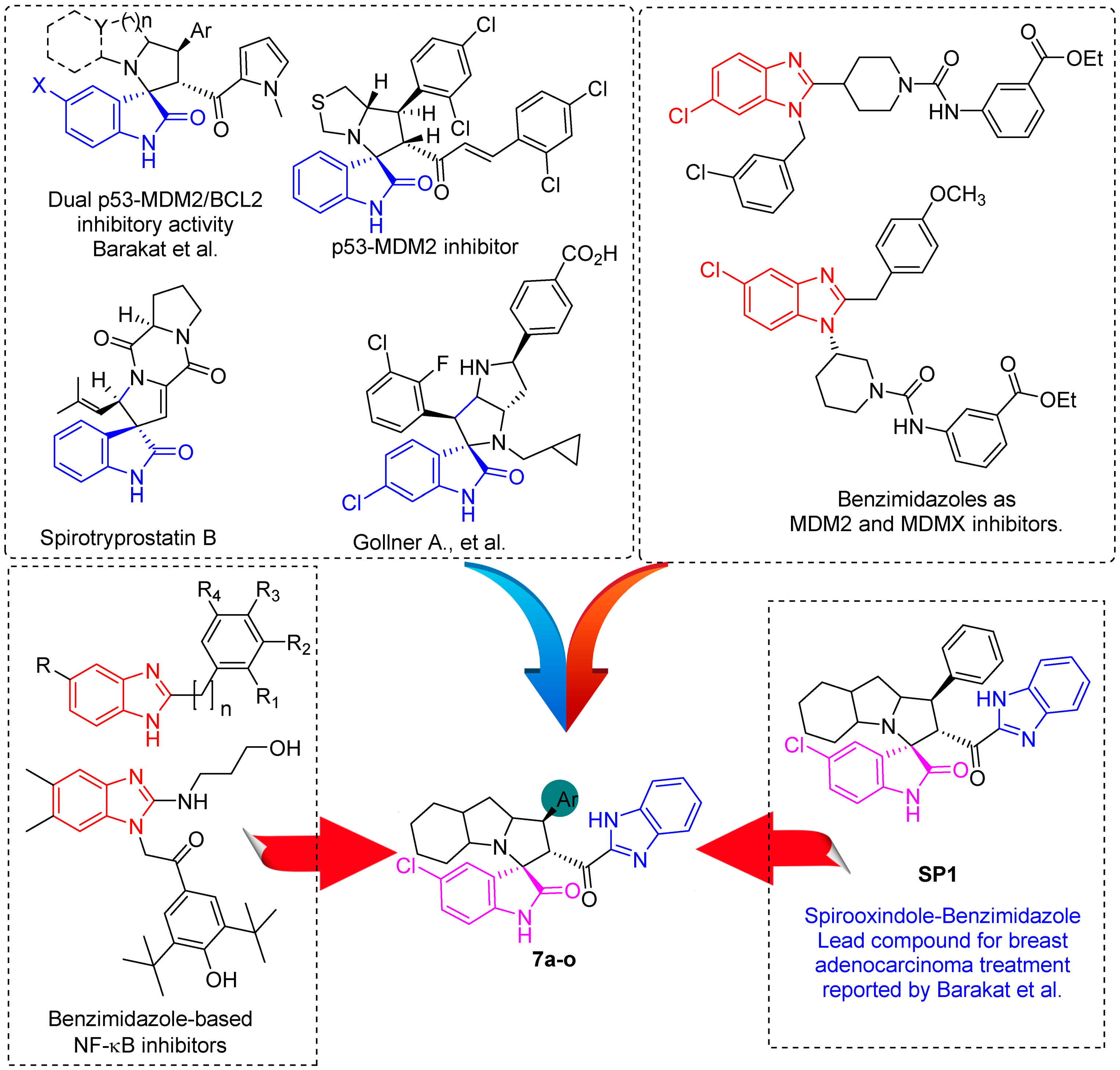
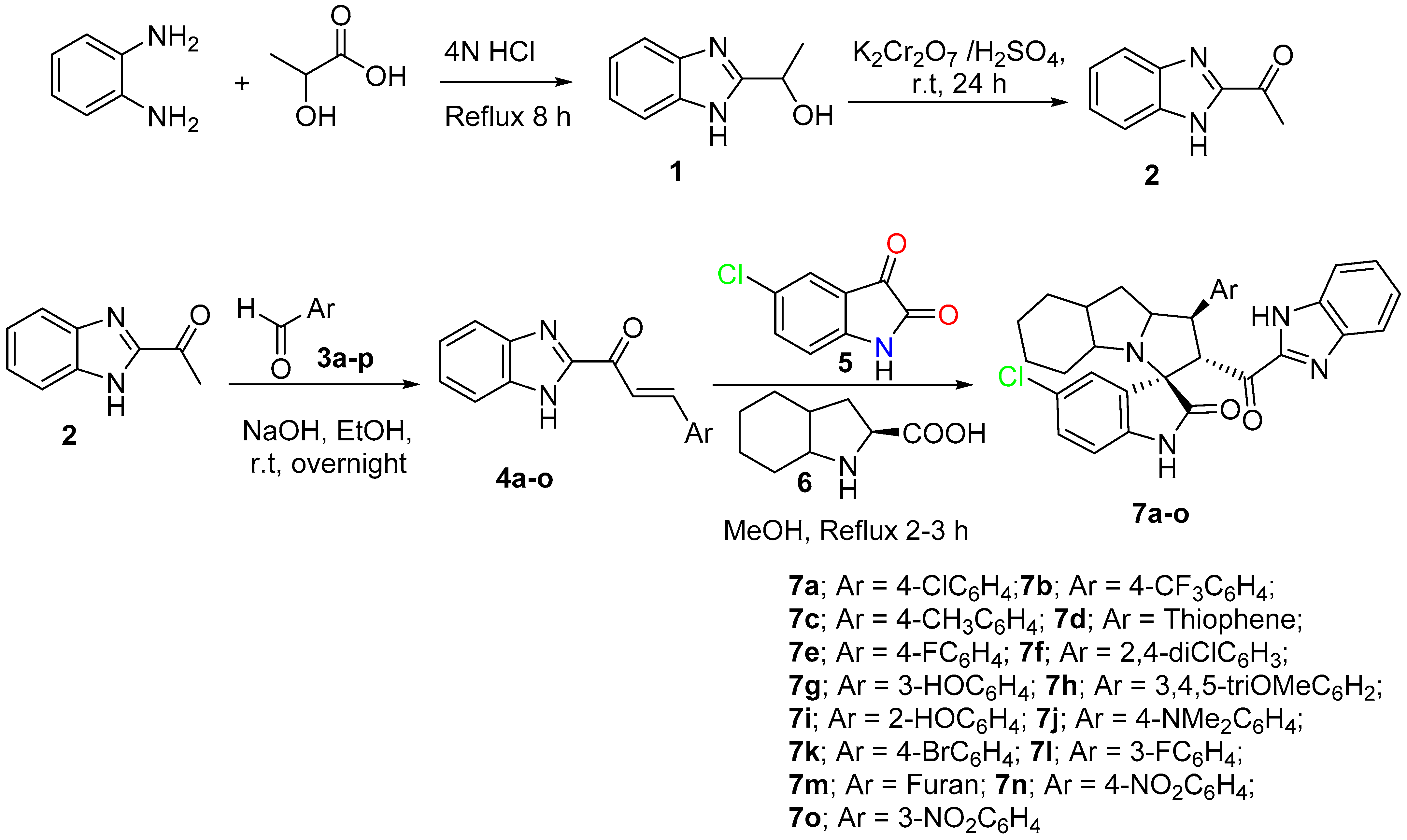
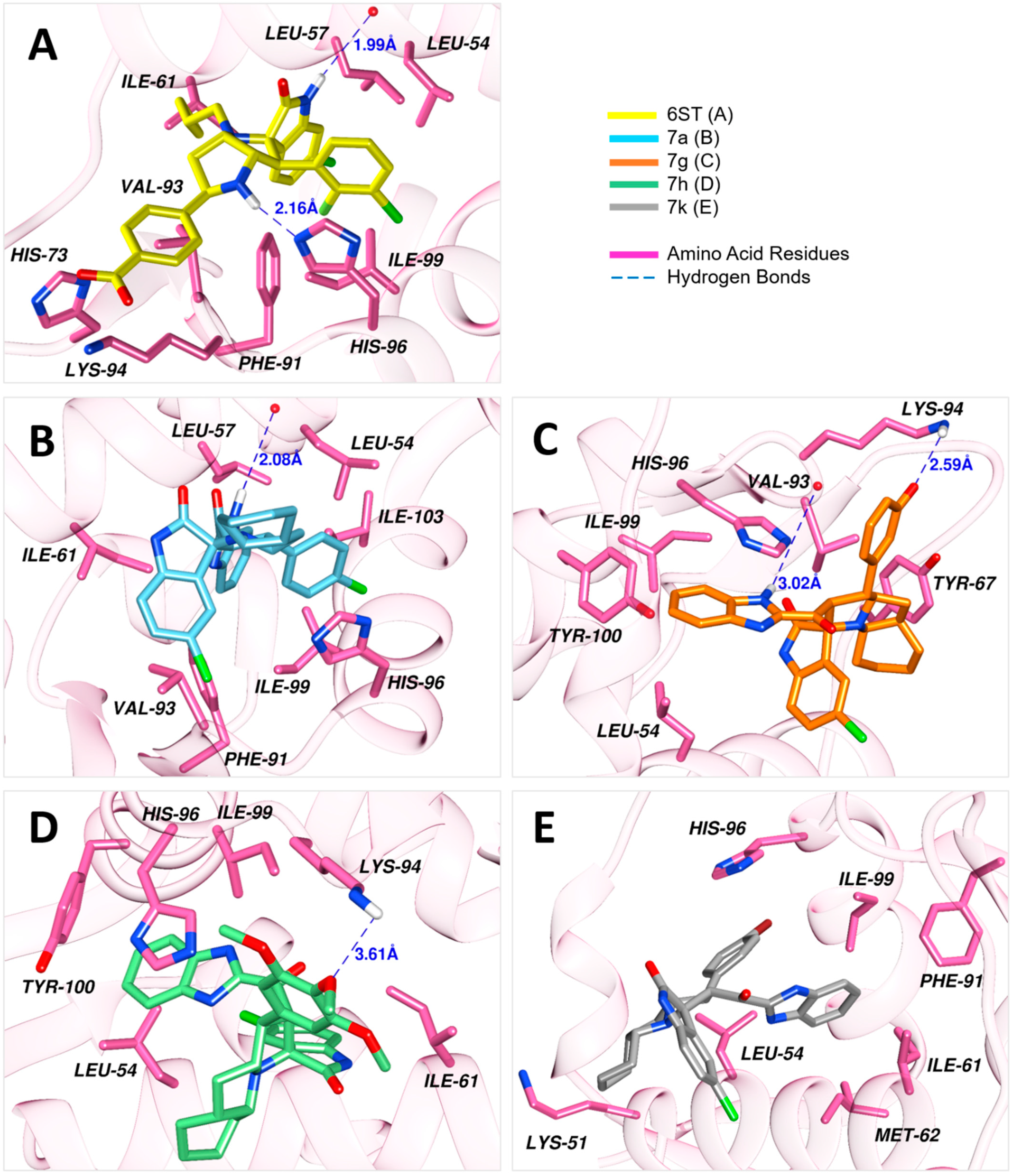
| Chemical Structure | Wi-38 | MDA-MB 231 | PC3 |
|---|---|---|---|
| IC50 (μM) | |||
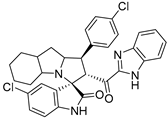 7a | 5.178 ± 0.333 | 4.763 ± 0.069 | 4.574 ± 0.011 |
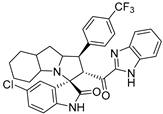 7b | 5.157 ± 0.039 | 4.284 ± 0.007 | 4.404 ± 0.008 |
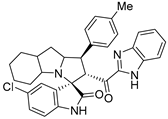 7c | 4.466 ± 0.088 | 4.221 ± 0.070 | 4.504 ± 0.059 |
 7d | 4.325 ± 0.062 | 3.797 ± 0.205 | 4.314 ± 0.036 |
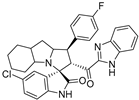 7e | 4.024 ± 0.011 | 4.143 ± 0.164 | 4.252 ± 0.128 |
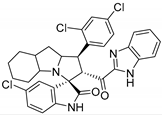 7f | 5.084 ± 0.152 | 4.274 ± 0.167 | 4.388 ± 0.008 |
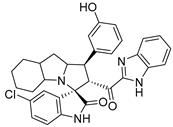 7g | 5.120 ± 0.115 | 4.329 ± 0.163 | 4.294 ± 0.023 |
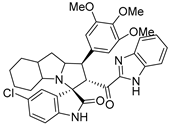 7h | 4.938 ± 0.161 | 4.261 ± 0.095 | 4.241 ± 0.045 |
 7i | 4.854 ± 0.009 | 4.371 ± 0.174 | 4.495 ± 0.034 |
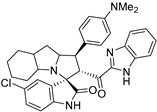 7j | 4.267 ± 0.153 | 4.261 ± 0.079 | 4.420 ± 0.008 |
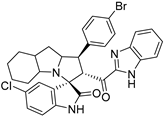 7k | 4.316 ± 0.007 | 4.479 ± 0.313 | 4.539 ± 0.094 |
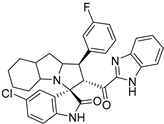 7l | 4.401 ± 0.092 | 4.156 ± 0.135 | 4.360 ± 0.208 |
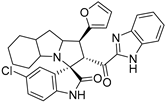 7m | 4.698 ± 0.129 | 6.039 ± 0.111 | 5.098 ± 0.119 |
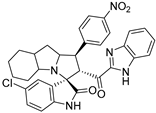 7n | 3.959 ± 0.046 | 6.879 ± 0.308 | 7.567 ± 0.709 |
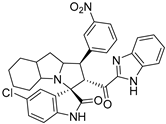 7o | 5.187 ± 0.089 | 4.138 ± 0.186 | 4.275 ± 0.005 |
| # | Code | Chemical Structures | KD (µM) |
|---|---|---|---|
| 1 | 7a | 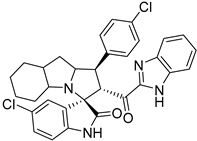 | 2.38 |
| 2 | 7g |  | 38 |
| 3 | 7h | 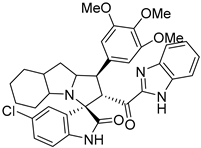 | 10.6 |
| 4 | 7k | 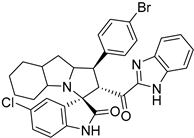 | No binding detected |
| Cpd. ID | S (kcal/mol) | Hydrogen Bonding | Hydrophobic Interactions | Other Interactions | ||
|---|---|---|---|---|---|---|
| Residues | Ligand Residues | Distance (Å) | ||||
| 7a | −7.05 | Leu54 | N-H of benzmidazole | 2.08 | Leu54, Leu57, Ile61, Phe91, Val93, Ile99, Ile103 | π-stacking, Halogen bonding with His96 |
| 7g | −7.09 | Val93 | N-H of benzmidazole | 3.02 | Leu54, Tyr67, Ile99, Tye100 | π-stacking with His96 |
| Lys94 | O of phenol ring | 2.59 | ||||
| 7h | −7.43 | Lys94 | O of methoxy | 3.29 | Leu54, Ile61, Ile99 | π-stacking with His96, Tyr100 |
| 7k | −7.29 | - | - | - | Lys51, Leu54, Leu57, Ile61, Phe91, Ile99 | halogen bonding with His96 |
| 6ST | −8.97 | Leu54 | N-H of indolinone | 1.99 | Leu54, Leu57, Ile61, Phe91, Val93, Lys94, Ile99 | π-stacking, Halogen bonding with His96; salt bridge with His73, Lys94 |
| His96 | N-H of pyrrolidine | 2.16 | ||||
Disclaimer/Publisher’s Note: The statements, opinions and data contained in all publications are solely those of the individual author(s) and contributor(s) and not of MDPI and/or the editor(s). MDPI and/or the editor(s) disclaim responsibility for any injury to people or property resulting from any ideas, methods, instructions or products referred to in the content. |
© 2023 by the authors. Licensee MDPI, Basel, Switzerland. This article is an open access article distributed under the terms and conditions of the Creative Commons Attribution (CC BY) license (https://creativecommons.org/licenses/by/4.0/).
Share and Cite
Alshahrani, S.; Al-Majid, A.M.; Ali, M.; Alamary, A.S.; Abu-Serie, M.M.; Dömling, A.; Shafiq, M.; Ul-Haq, Z.; Barakat, A. Rational Design, Synthesis, Separation, and Characterization of New Spiroxindoles Combined with Benzimidazole Scaffold as an MDM2 Inhibitor. Separations 2023, 10, 225. https://doi.org/10.3390/separations10040225
Alshahrani S, Al-Majid AM, Ali M, Alamary AS, Abu-Serie MM, Dömling A, Shafiq M, Ul-Haq Z, Barakat A. Rational Design, Synthesis, Separation, and Characterization of New Spiroxindoles Combined with Benzimidazole Scaffold as an MDM2 Inhibitor. Separations. 2023; 10(4):225. https://doi.org/10.3390/separations10040225
Chicago/Turabian StyleAlshahrani, Saeed, Abdullah Mohammed Al-Majid, M. Ali, Abdullah Saleh Alamary, Marwa M. Abu-Serie, Alexander Dömling, Muhammad Shafiq, Zaheer Ul-Haq, and Assem Barakat. 2023. "Rational Design, Synthesis, Separation, and Characterization of New Spiroxindoles Combined with Benzimidazole Scaffold as an MDM2 Inhibitor" Separations 10, no. 4: 225. https://doi.org/10.3390/separations10040225
APA StyleAlshahrani, S., Al-Majid, A. M., Ali, M., Alamary, A. S., Abu-Serie, M. M., Dömling, A., Shafiq, M., Ul-Haq, Z., & Barakat, A. (2023). Rational Design, Synthesis, Separation, and Characterization of New Spiroxindoles Combined with Benzimidazole Scaffold as an MDM2 Inhibitor. Separations, 10(4), 225. https://doi.org/10.3390/separations10040225









